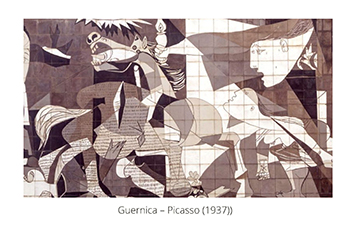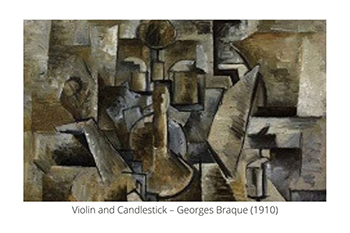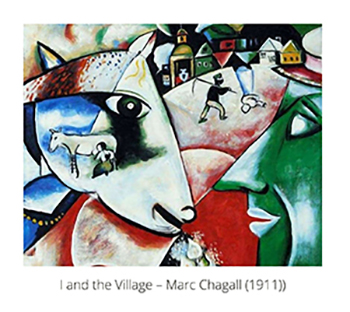Cubism is a style of painting
in which the subject matter is presented as geometric forms. Unlike traditional
still - life paintings, landscape or portrait paintings, Cubist paintings are
not meant to be realistic or lifelike in any way. The artist has looked at the
subject from every angle and pieced together fragments from different vantage
points into one painting. The artists
who follow cubism, explain that their attempt is to give a fuller, more
detailed explanation of the subject.
The term Cubism was
constructed by Louis Vauxcelles, an influential 20th Century French
art critic. He wrote a critique around the year 1907, about artists who had
begun painting using entirely geometric shapes. He called them "little cubes".
By 1911, Cubism became a common name and was known as an exciting abstract
style. Cubism is at art movement which completely changed the face of European
painting and sculpture. It is considered an art movement with the greatest
influence on modern art.
 There are 2 distinct types of
Cubism as well, Analytic cubism, as explained by an artist, is an attempt to
give a fuller, more detailed explanation of a subject. Synthetic cubism, on the
other hand is an extension of Analytic cubism, instead of breaking down a
subject into pieces, it involves assembling pieces already available into a
collage. It is said to be fairly geometric in nature.
There are 2 distinct types of
Cubism as well, Analytic cubism, as explained by an artist, is an attempt to
give a fuller, more detailed explanation of a subject. Synthetic cubism, on the
other hand is an extension of Analytic cubism, instead of breaking down a
subject into pieces, it involves assembling pieces already available into a
collage. It is said to be fairly geometric in nature.
When looking at this style of
art philosophically, it is a theory of symbolic democracy, where every element
is valued the same. Intellectually, it is an admission that life is complex and
can only be understood from multiple perspectives. Metaphorically speaking, it
is a tool for fully exploring a subject, to understand its essence and to
achieve a vision of it that is complete.
The most famous Cubist artist
is probably Picasso. Through this article, we look at some of best Cubist
paintings of the 20th century.
 Guernica - Picasso (1937)
Guernica - Picasso (1937)
This is an oil on canvas painting
which is regarded as one of the most powerful anti-war paintings in history. It
is a creation which helped bring attention to the Spanish civil war. Guernica
is considered one of Picasso's most popular paintings and has a distinct Cubist
style.
Portrait of Picasso - Juan
Gris (1912)
Juan Gris was recognized as a
cubist painter after creating this piece. At that time, Gris's work was the
first Cubist painting created without the influence of Braque or Picasso. The
painting portrays the artist, Picasso at a young age, with his hair in place,
holding a palette. The creation was neat, and it was later critiqued as most
Cubist paintings are disorganized.
Man on a Balcony - Albert
Gleizes (1912)
Albert Gleizes demonstrates
the principles of Cubism through this outstanding work of art. It is a large
oil painting titled "Man on a Balcony". The artist intentionally created a
contrast of angular and curved shapes and block like forms of the figure and
head are created with the principles of cubism in mind.
 Violin and Candlestick - Georges
Braque (1910)
Violin and Candlestick - Georges
Braque (1910)
Violin and Candlestick
depicts an abstract violin and candlestick still life painting. It is colored
in muted shades of brown, grey and black. It consists mainly of flat,
horizontal brush strokes and sharp outlines.
I and the Village - Marc Chagall (1911)
Marc Chagall is a Russian -French painter
and printmaker. His painting "I and the Village" portrays and autobiographical
scenes from his childhood in Russia. There are folk symbols and elements from
the town of Vitebsk, where Chagall grew up. This is a highly emotional painting
which has geometric panels and blended colors which confuses the audience.
Cubism is one of the most influential art
movements known. It helped change and develop a wide range of ideas in Art
during the 1910 - 1920. Cubism, defied the rules of art and has turned out to
be one of the greatest breaks in the history of Art.
Manesha Pieris (2022)